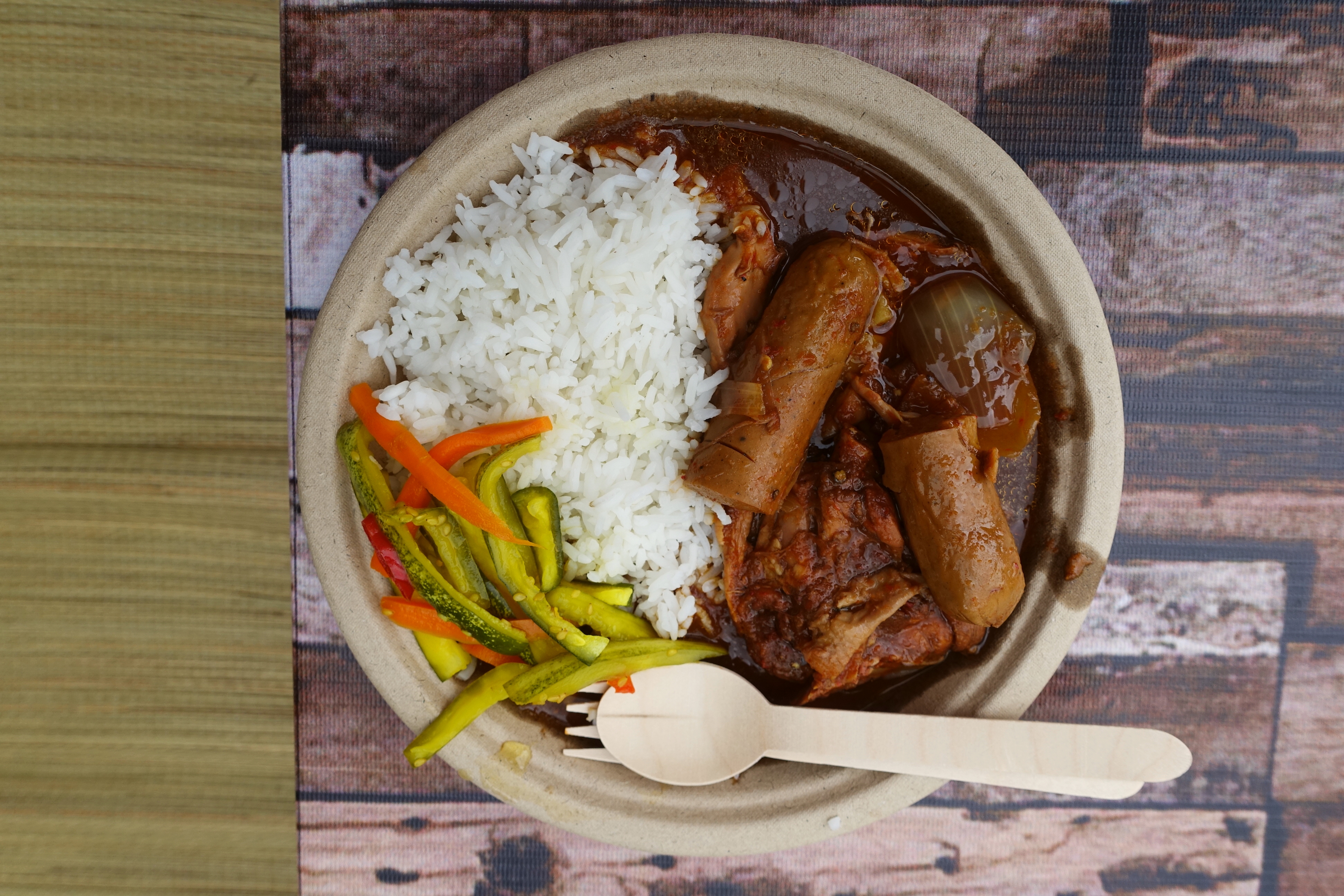The Mini Curry Fest was one of the more interesting events (for me, that is) in the current on-going Penang International Food Festival. The one-evening affair brought together different types of curries from across Asia, all in one spot at the Hin Bus Depot, Penang’s popular arts & craft hub.
Low wooden tables (constructed from repurposed wooden pallets) and rattan mats on the lawn provided customers with a very casual seating arrangement whilst one shops around for curries from the various stalls there. We had a great time sharing several types of curries, tasting from each other’s plates - it would have been an injustice to restrict oneself to just one type of curry. ![]()
I was with a whole bunch of friends and these were what we tried this evening:
-
Malaccan-Dutch Beef Smore
This spicy beef stew comes from Amelleia’s Eurasian Curry stall. The beef Smore is a slow-cooked stew, where the beef has been cooked till melt-in-the-mouth tender, tinted dark with soysauce, scented with cinnamon, yellow onions and peppercorns. Amelleia’s rendition had deep, mellow flavours. She served it on steamed white rice, garnished with Penang-style achar pickles (cucumbers & carrots in vinegar-turmeric marinade).
-
Malaccan-Portuguese Curry Devil
Another offering from Amelleia Chong - the Portuguese Curry Devil combines chicken with pork frankfurters in a burn-your-mouth, ultra-spicy curry. The name supposedly was Curry Debal originally - “debal” being a Cristang (a medieval Portuguese dialect used by Malacca’s 600-year-old Portuguese-Eurasian community) term referring to knick-knacks or leftovers. But since the curry was so spicy, the term morphed into “devil” for it being so hot. Curry Devil was one of those centuries-old dishes where copious amounts of vinegar and spices are added to the meats as a form of preservative in pre-refrigeration days (much like for Filipino adobo).
-
Mamak-style Chicken Curry (Gulai Ayam)
This Mamak or Indian-Muslim-style chicken curry is piquant with the use of South Indian spices/Tamilian spices. It’s served with puri - deep-fried, puffed up Indian leavened bread. Mamak-style Indian curries are heavy with cloves, cumin, coriander and cardamom. And quite a bit of fenugreek! The curry scent stays with you long after your meal.
-
Nyonya-style Chicken Curry (Gulai Kay), served with rice tinted blue with extract from the “bunga telang” (clitoria ternatea) flowers
This offering comes from Jason’s Nyonya stall. Nyonya-style curries resemble South Indian curries in its spicing, but it’s sweeter and much richer from the addition of coconut milk. Nyonya curries also often has fresh galangal, turmeric and lemongrass added to the spice mix, from the Siamese/Thai influence. Nyonya cuisine is about 500 years old, and its polyglot of influences reflect the inter-marriage between its dominant Chinese base with Indonesian, Thai and Indian influences.
-
Vietnamese-style Chicken Curry (Cà Ri Gà), served with Vietnamese baguette
I found Vietnamese-style curries to be pretty similar in “types of spices used” compared to our Nyonya curries in Singapore & Malaysia, except that the Vietnamese version is much lighter, and more liquified. The offering here from the Pho Viet stall was very tasty nonetheless. The French-influenced baguettes were perfect accompaniments to soak up the curry sauce.
-
Japanese Curry, served with Potato Croquettes
Fuku Japanese Restaurant’s stall offers the sweetish, mild Japanese-style curry, which owes its origins from the mid-19th-century Meiji era. There was a story that, at the time, young samurai noblemen sent to Europe to study Western ways encountered Indian curries cooked by the sailors on British ships they were on. The Japanese took a liking to the curries, but made it milder to suit the Japanese palate. Today, Japanese curries have distinct characteristics of its own.
-
Malay Curry Puffs and Nasi Lemak
This stall was set-up by Adam’s Curry Puffs from Pulau Tikus Market. Adam is justly famous for his curry puffs - crisp-fried pastries filled with curried potato-and chicken. The Malays also make terrific nasi lemak, coconut-scented rice slathered with a spicy chili-tamarind sauce, accompanied by a tiny piece of fried fish and a small sliver of egg omelette.
-
Som Tum (Thai Green Papaya Salad)
We were in the throes of curry overload within the hour and decided to skip the Thai green and red curries from Nine Thai stall. But we opted for a spicy som tum salad instead. No respite from the heat here!
-
Tek Tarik
The teh tarik is South Indian-style sweet milk tea, “pulled” (in Malay, it’s called “tarik”) between two cups until it achieved a foamy top. Delicious accompaniment to a spicy curry meal. The “Teh Tarik Man” can sometimes be quite theatrical in the way he pulls the tea, as was the case here.
The Temple of Fine Arts provided classical South Indian music that evening.
















